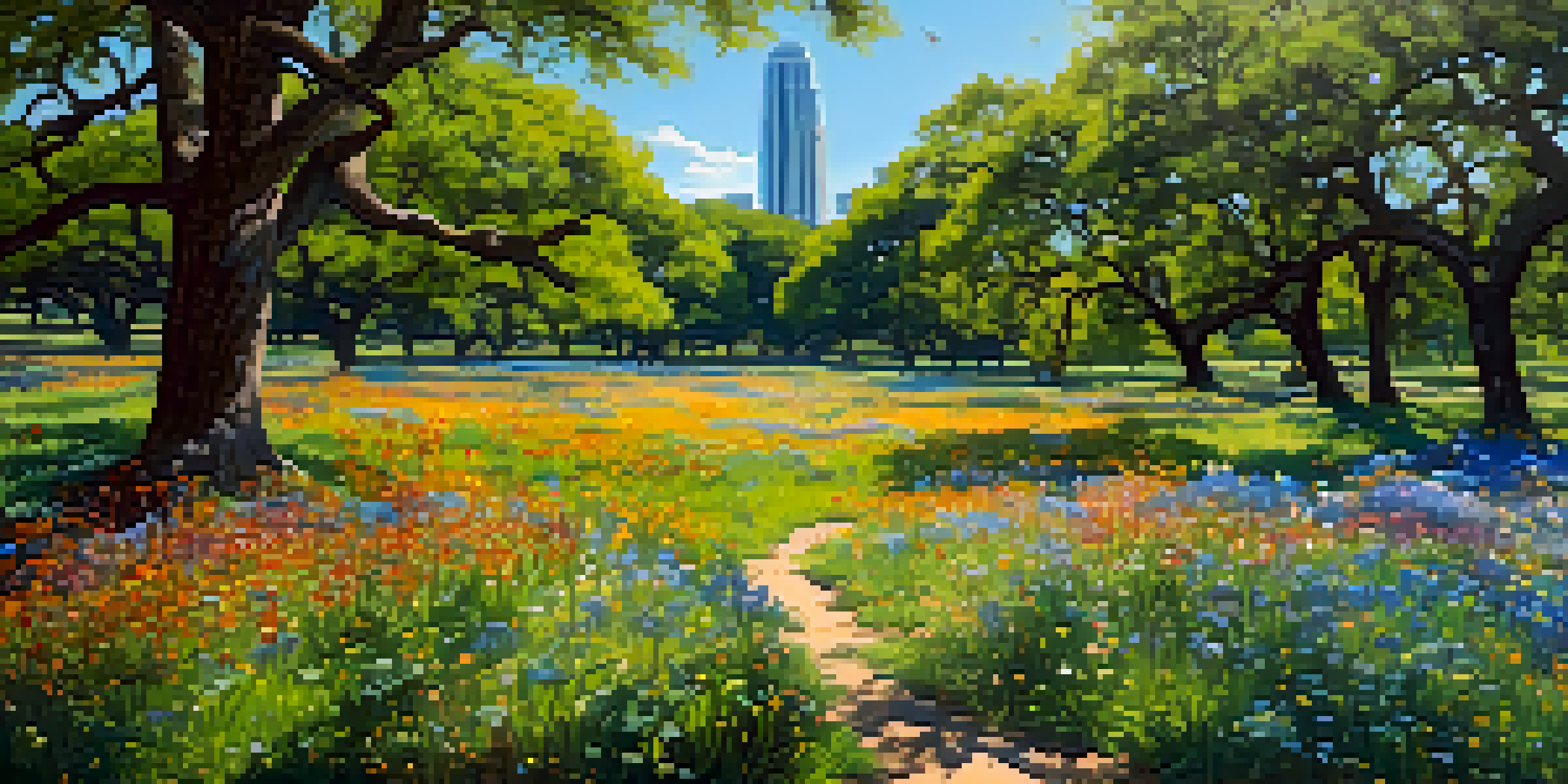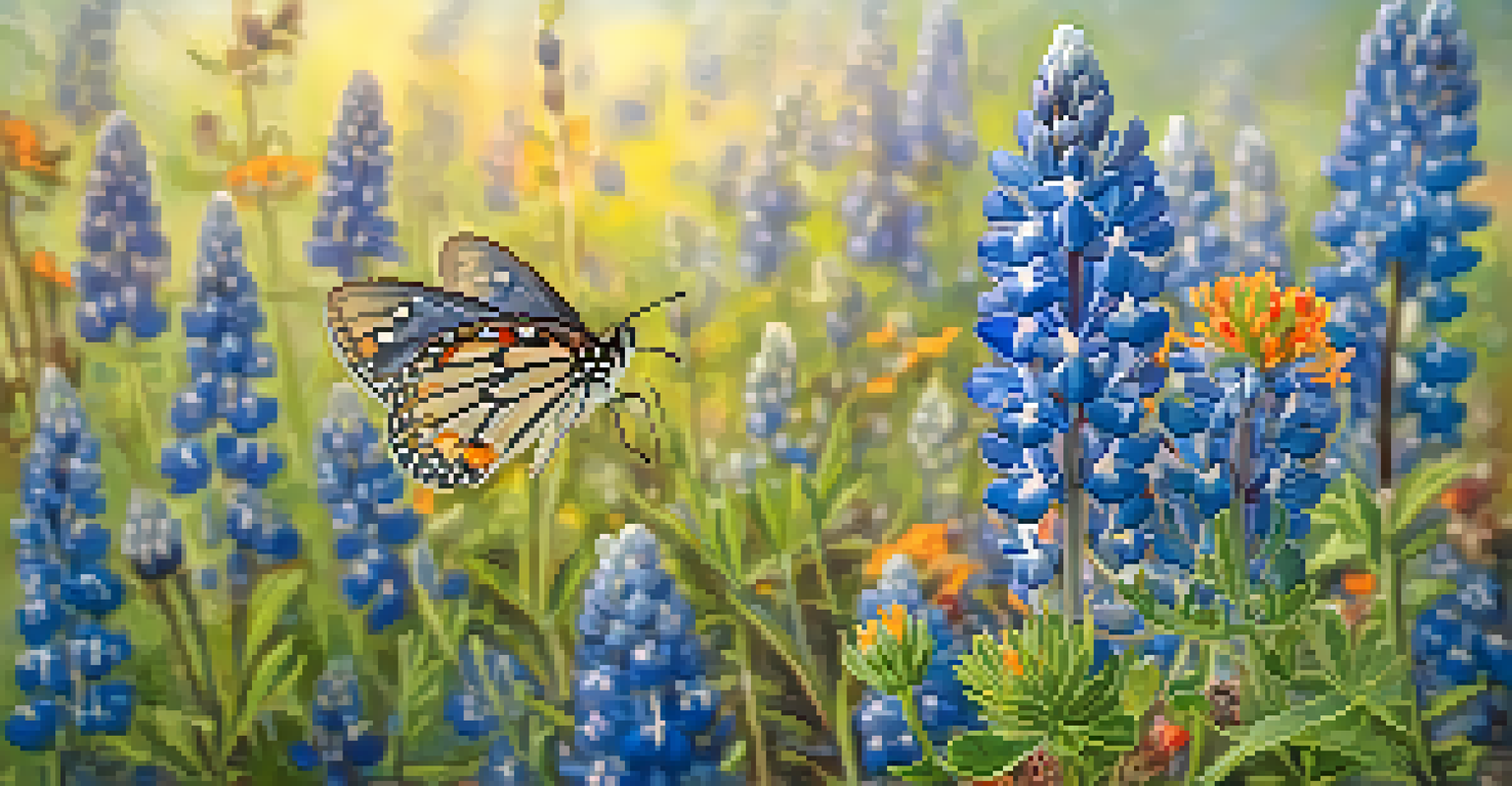Exploring the Diverse Flora and Fauna in Austin Parks

The Unique Ecosystems of Austin's Parks
Austin's parks are not just green spaces; they are vibrant ecosystems brimming with life. From the lush greenery of Zilker Park to the serene waters of Lady Bird Lake, each area supports a unique blend of flora and fauna. These ecosystems offer a habitat for countless species, making them essential for biodiversity in urban settings.
In every walk with nature, one receives far more than he seeks.
What’s fascinating is how these parks serve as refuge zones for wildlife amidst the bustling city. For example, the diverse plant life provides food and shelter for many bird species, including the American Robin and the Northern Cardinal. Understanding these ecosystems helps us appreciate the importance of preserving these natural habitats.
Moreover, the parks’ ecosystems are dynamic; they change with the seasons, showcasing different plants and wildlife throughout the year. Spring brings vibrant wildflowers, while fall reveals the stunning foliage of oak and maple trees. By exploring these parks, you can witness the beauty of nature's cycles firsthand.
Native Plants of Austin Parks
Austin parks are home to a variety of native plants that thrive in the local climate and soil conditions. Species like the Texas Bluebonnet and the Blackfoot Daisy not only add color to the landscape but also play a critical role in supporting local wildlife. These plants are well-adapted to the region, making them resilient to droughts and pests.

By planting native species, we can create a sustainable environment that requires less maintenance and water. This approach also fosters a sense of place, connecting residents and visitors to the natural heritage of Texas. As you stroll through parks, take a moment to appreciate how these plants have adapted over time to their surroundings.
Diverse Ecosystems in Austin Parks
Austin's parks serve as vital ecosystems that support a rich variety of plant and animal life, contributing significantly to urban biodiversity.
Additionally, many native plants offer food and shelter for local pollinators, such as bees and butterflies. These creatures are essential for pollinating flowers and crops, highlighting the interconnectedness of life in Austin's parks. Supporting native plants is a small yet impactful way to contribute to the local ecosystem.
Birdwatching Opportunities in Austin Parks
Austin’s parks are a paradise for birdwatchers, drawing enthusiasts from near and far. With over 300 species recorded in the area, you'll find everything from majestic hawks soaring overhead to colorful warblers flitting among the branches. Parks like the Balcones Canyonlands National Wildlife Refuge provide excellent vantage points for spotting these feathered friends.
The Earth has music for those who listen.
Birdwatching is not just a relaxing hobby; it also promotes environmental awareness. Observing birds in their natural habitats encourages us to consider the ecological challenges they face, such as habitat loss and climate change. By participating in birdwatching, we become advocates for protecting these species and their environments.
Whether you're an experienced birder or just starting out, Austin’s parks have something to offer everyone. Bring a pair of binoculars and a field guide, and you’ll be amazed at what you can discover. Each visit can reveal new species, making every outing an exciting adventure in nature.
Mammals of Austin Parks: A Hidden Treasure
While birds tend to steal the spotlight, Austin's parks are also home to a variety of mammals. From playful raccoons to elusive coyotes, the diverse wildlife is often hidden in plain sight. Many mammals are nocturnal, making them challenging to spot during the day, but their presence is felt in the tracks and signs they leave behind.
Exploring these parks at dawn or dusk can increase your chances of encountering some of these fascinating creatures. The Lone Star State is home to unique mammals like the Texas Opossum and the Nine-Banded Armadillo, both of which play important roles in their ecosystems. Learning about these animals enhances our appreciation for the wildlife that shares our urban spaces.
Importance of Native Plants
Native plants in Austin parks, such as the Texas Bluebonnet, enhance local wildlife habitats while being resilient to the region's climate.
Additionally, understanding the behaviors and habitats of these mammals can foster a deeper connection to nature. For instance, knowing that deer are most active in the early morning can inspire you to rise early and witness the beauty of wildlife awakening. Each sighting is a reminder of the rich diversity that exists within our parks.
The Role of Pollinators in Austin's Parks
Pollinators, such as bees, butterflies, and hummingbirds, play a vital role in maintaining the health of Austin's parks. These creatures facilitate the reproduction of flowering plants, which in turn supports the entire ecosystem. Their efforts are essential for producing fruits, vegetables, and many of the foods we enjoy.
Austin has made strides in promoting pollinator-friendly habitats through community initiatives and education. By planting flowering plants and reducing pesticide use, we can create inviting spaces for these important insects. As you explore parks, consider how you can contribute to sustaining these vital species.
The beauty of observing pollinators at work is simply enchanting. Watching a butterfly dance from flower to flower or seeing a bee busily collecting nectar can be a meditative experience. By nurturing a love for these little creatures, we can inspire others to protect their habitats and the parks we cherish.
Conservation Efforts in Austin Parks
As urbanization continues to expand, conservation efforts are crucial for preserving the natural beauty of Austin's parks. Various organizations and volunteers work tirelessly to restore habitats, remove invasive species, and educate the public about the importance of biodiversity. Their dedication ensures that future generations can enjoy the rich flora and fauna these parks offer.
Community involvement is a key aspect of these conservation efforts. Local clean-up days and planting events not only enhance the parks but also foster a sense of community and connection to nature. Engaging with these initiatives is a rewarding way to contribute to the health of local ecosystems.
Engaging in Conservation Efforts
Community involvement in conservation initiatives is essential for preserving the natural beauty and biodiversity of Austin's parks.
By understanding the challenges faced by Austin's parks, we can all become informed stewards of the environment. Supporting local conservation efforts, whether through volunteering or simply spreading awareness, plays a significant role in safeguarding the flora and fauna that make these parks so special.
Experiencing the Beauty of Austin Parks
Exploring Austin’s parks offers a unique opportunity to connect with nature and discover its wonders. Whether you're hiking the trails, picnicking with family, or simply enjoying the scenery, each visit can reveal new aspects of the diverse flora and fauna. Engaging with nature in this way promotes mental well-being and a sense of peace.
The best part about these parks is that they cater to everyone, from nature enthusiasts to families looking for a fun day out. With activities ranging from birdwatching to photography, there’s something for everyone to enjoy. Each park has its own character and charm, inviting you to explore and experience its unique offerings.

So, grab your walking shoes and get ready to dive into Austin's natural beauty. Every step you take in these parks is a chance to learn, appreciate, and connect with the incredible variety of life that thrives just outside our doors. The diverse flora and fauna of Austin parks are waiting for you to discover them!